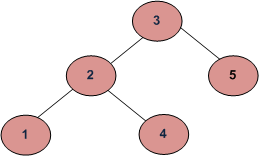A program to check if a binary tree is BST or not
A binary search tree (BST) is a node based binary tree data structure which has the following properties.
• The left subtree of a node contains only nodes with keys less than the node’s key.
• The right subtree of a node contains only nodes with keys greater than the node’s key.
• Both the left and right subtrees must also be binary search trees.
• The left subtree of a node contains only nodes with keys less than the node’s key.
• The right subtree of a node contains only nodes with keys greater than the node’s key.
• Both the left and right subtrees must also be binary search trees.
From the above properties it naturally follows that:
• Each node (item in the tree) has a distinct key.
• Each node (item in the tree) has a distinct key.
METHOD 1 (Simple but Wrong)
Following is a simple program. For each node, check if left node of it is smaller than the node and right node of it is greater than the node.
Following is a simple program. For each node, check if left node of it is smaller than the node and right node of it is greater than the node.
int isBST(struct node* node)
{
if (node == NULL)
return 1;
/* false if left is > than node */
if (node->left != NULL && node->left->data > node->data)
return 0;
/* false if right is < than node */
if (node->right != NULL && node->right->data < node->data)
return 0;
/* false if, recursively, the left or right is not a BST */
if (!isBST(node->left) || !isBST(node->right))
return 0;
/* passing all that, it's a BST */
return 1;
}
This approach is wrong as this will return true for below binary tree (and below tree is not a BST because 4 is in left subtree of 3)
METHOD 2 (Correct but not efficient)
For each node, check if max value in left subtree is smaller than the node and min value in right subtree greater than the node.
/* Returns true if a binary tree is a binary search tree */
int isBST(struct node* node)
{
if (node == NULL)
return(true);
/* false if the max of the left is > than us */
if (node->left!=NULL && maxValue(node->left) > node->data)
return(false);
/* false if the min of the right is <= than us */
if (node->right!=NULL && minValue(node->right) < node->data)
return(false);
/* false if, recursively, the left or right is not a BST */
if (!isBST(node->left) || !isBST(node->right))
return(false);
/* passing all that, it's a BST */
return(true);
}
It is assumed that you have helper functions minValue() and maxValue() that return the min or max int value from a non-empty tree
METHOD 3 (Correct and Efficient)
Method 2 above runs slowly since it traverses over some parts of the tree many times. A better solution looks at each node only once. The trick is to write a utility helper function isBSTUtil(struct node* node, int min, int max) that traverses down the tree keeping track of the narrowing min and max allowed values as it goes, looking at each node only once. The initial values for min and max should be INT_MIN and INT_MAX — they narrow from there.
/* Returns true if the given tree is a binary search tree
(efficient version). */
int isBST(struct node* node)
{
return(isBSTUtil(node, INT_MIN, INT_MAX));
}
/* Returns true if the given tree is a BST and its
values are >= min and <= max. */
int isBSTUtil(struct node* node, int min, int max)
Implementation:C
#include <stdio.h> #include <stdlib.h> #include <limits.h> /* A binary tree node has data, pointer to left child and a pointer to right child */ struct node { int data; struct node* left; struct node* right; }; int isBSTUtil(struct node* node, int min, int max); /* Returns true if the given tree is a binary search tree (efficient version). */ int isBST(struct node* node) { return(isBSTUtil(node, INT_MIN, INT_MAX)); } /* Returns true if the given tree is a BST and its values are >= min and <= max. */ int isBSTUtil(struct node* node, int min, int max) { /* an empty tree is BST */ if (node==NULL) return 1; /* false if this node violates the min/max constraint */ if (node->data < min || node->data > max) return 0; /* otherwise check the subtrees recursively, tightening the min or max constraint */ return isBSTUtil(node->left, min, node->data-1) && // Allow only distinct values isBSTUtil(node->right, node->data+1, max); // Allow only distinct values } /* Helper function that allocates a new node with the given data and NULL left and right pointers. */ struct node* newNode(int data) { struct node* node = (struct node*) malloc(sizeof(struct node)); node->data = data; node->left = NULL; node->right = NULL; return(node); } /* Driver program to test above functions*/ int main() { struct node *root = newNode(4); root->left = newNode(2); root->right = newNode(5); root->left->left = newNode(1); root->left->right = newNode(3); if(isBST(root)) printf("Is BST"); else printf("Not a BST"); getchar(); return 0; }


Comments
Post a Comment